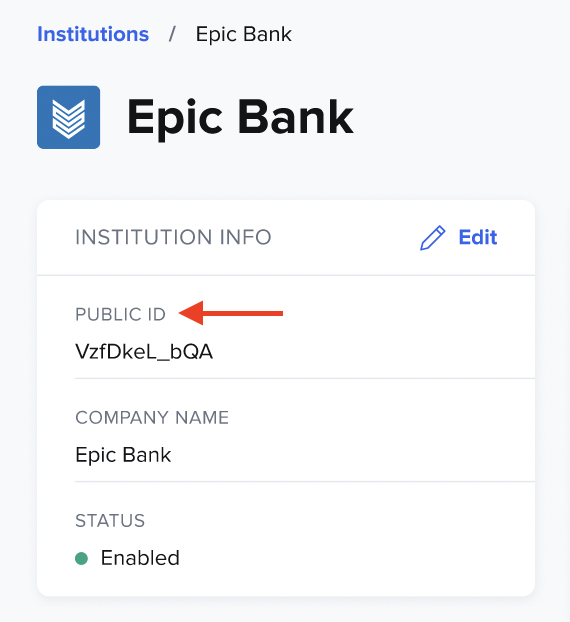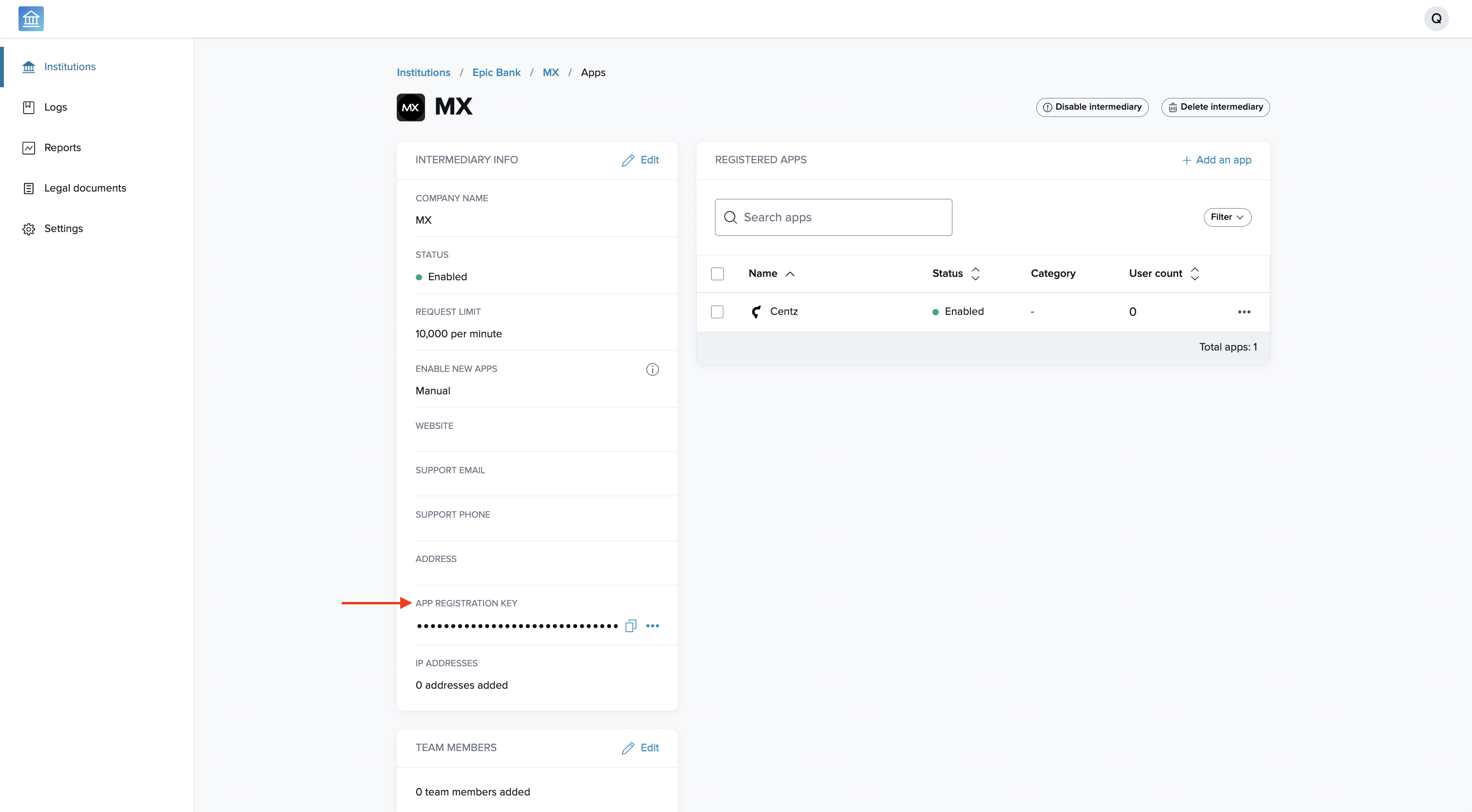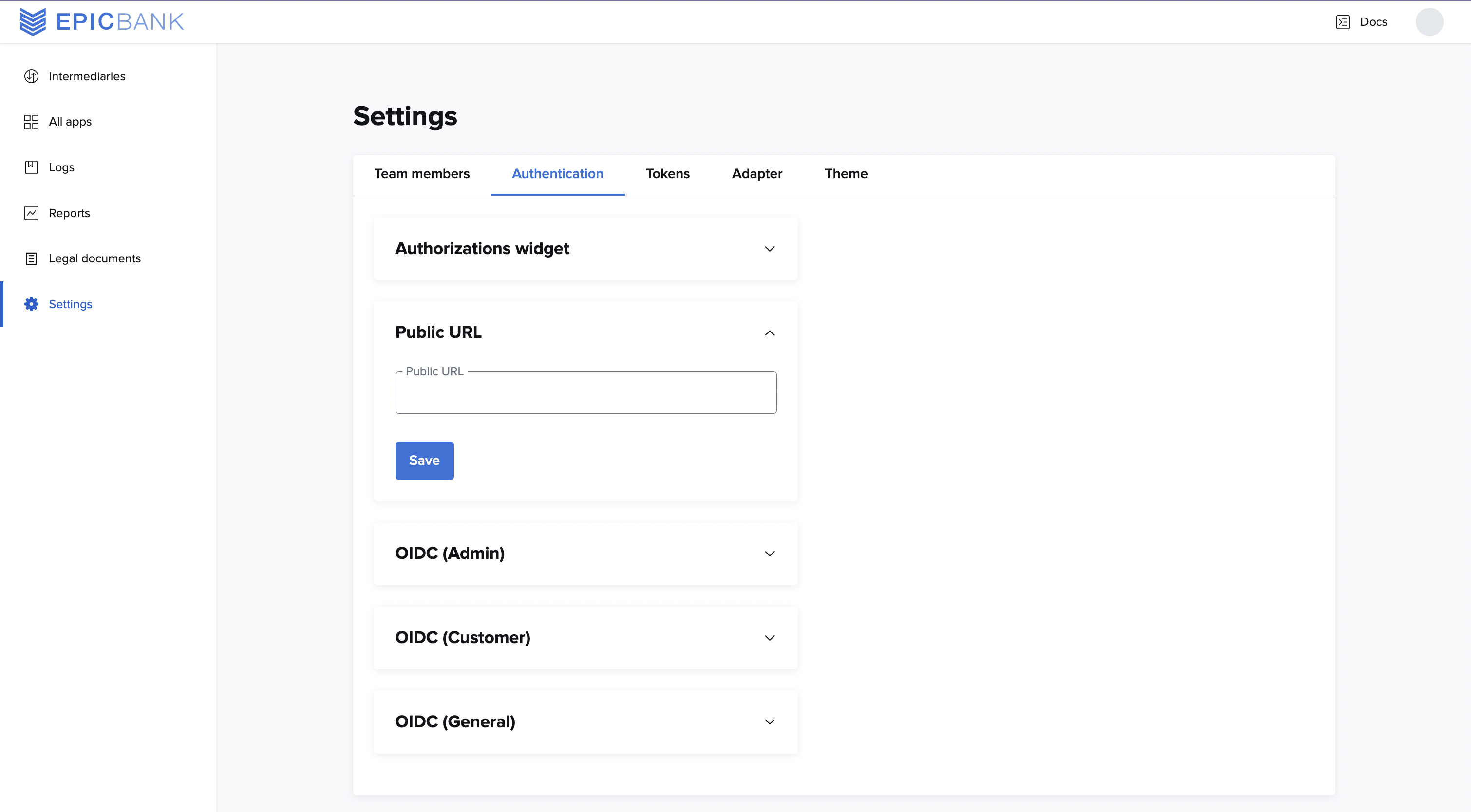Institutions
This feature shows all institutions connected to you as a channel partner. You can add new institutions or edit existing ones. You can view institution info and the team members, settings, intermediaries, and apps specific to that institution.
Add an Institution
To add an institution:
- Select + Add.
- Enter a name for the institution.
- Adjust the institution’s status, if needed.
- When set to Enabled, all API requests received by the institution will be accepted.
- When set to Disabled, all API requests received by this institution will be rejected.
- When set to Needs review, all API requests received by this Institution will be rejected and notes that details about this institution must be reviewed before enabling.
- Create the institution’s first admin user by entering the first name, last name, and company email of the person at the institution who will primarily manage their instance of Data Access.
- When all inputs are filled, select Add.
When an institution is added, an email will be sent to the institution’s admin inviting them to log in to the Data Provider Portal and set up their instance of Data Access.

Edit an Institution
You can edit the following institution details:
- Institution name: This is the name of institution inside the Channel Partner Portal.
- Status: This determines the status of the institution’s API.
- When set to Enabled, all API requests received by the institution will be accepted.
- When set to Disabled, all API requests received by this institution will be rejected.
- When set to Needs review, all API requests received by this institution will be rejected and notes that details about this institution must be reviewed before enabling.
The Institution's Public ID
When viewing an institution's details, you'll see the public ID in the Institution info column. This is a unique public identifier used during initial testing and configuration. It allows admins to access their Data Provider Portal before DNS records have been added.
For example, the admin would visit /institutions/{public_id}/admin. After DNS records have been added, this route would be epic-bank.com/admin.

Intermediaries
Intermediaries are data recipients who register apps to consume the APIs of your institutions.
From the institution details page, you can access a table of all intermediaries that have been added to the associated institution. This table shows the status of the intermediary and how many apps are registered with it.
Add an Intermediary
MX recommends that the institution add and manage all intermediaries from their own Data Provider Portal. However, if needed, channel partner admins can create intermediaries on their behalf. To add an intermediary:
- Select the institution you want to add an intermediary to.
- Select +Add.
- Enter the following info about the intermediary:
- Logo
- Name
- Adjust the intermediary's status if needed.
- When set to Enabled, all API requests flow freely to this intermediary and their registered apps.
- When set to Disabled, all API requests from this intermediary and their registered apps will be rejected.
- When set to Needs review, all API requests from this intermediary will be rejected, and notes that the intermediary’s apps and settings need to be reviewed before enabling.
- The website, support email, support phone, address, city, state, and zip fields are optional. These fields help other team members identify the intermediary and who to contact if support is needed.
- Set a request limit and frequency.
- If the intermediary exceeds the request limit, any subsequent requests will be blocked. If you don’t want to set a request limit, select the Disable request limit checkbox.
- Tip: A request is counted each time one of the FDX endpoints is hit. For example,
GET /accountswould be one request.
- Select whether any new apps that are registered with the intermediary are auto-approved or not. If this is set to manual, the data provider admin will have to manually enable each newly registered app.
- Enter the IP addresses for the intermediary.
- You can add multiple addresses if needed.
- When the form is complete, select Add.

After the intermediary has been added, select it from the list. In the Intermediary Info column, you will find the app registration key. Send this key back to the intermediary to enable them to use the dynamic client registration endpoint.
Rotate App Registration Keys
If an intermediary’s app registration key is compromised, or if your security and compliance team requires these keys be rotated regularly:
- Select •••.
- Select Rotate key.
The new key will need to be sent back to the intermediary in order for them to register any new apps or update existing apps.
Disable an Intermediary
If an intermediary’s status is set to Disabled, all requests that come from any app registered with it will be rejected and a 429 HTTP status code will be returned.
To disable an intermediary:
- Select the intermediary you want to disable.
- Select Disable.
Enable an Intermediary
If an intermediary’s status is set to Enabled, all API requests that come from that intermediary and its registered apps will be accepted.
To enable an intermediary:
- Select the intermediary you want to enable.
- Select Enable.
Delete an Intermediary
Deleting an intermediary will also delete all of the apps that are registered with it. It will also be removed from the intermediaries table. Any subsequent requests that come from the deleted intermediary will be rejected. This cannot be undone.
To delete an intermediary:
- Select the intermediary you want to delete.
- Select Delete.
- Select Yes, delete from the confirmation modal.
Apps
From an intermediary's details page, you can access a table of all of the apps that have been added to that intermediary. In the table you’ll find the app’s status, category, and unique user count.
You can select an app to view important details, such as the app's:
- Status (enabled, disabled, needs review)
- Redirect URI
- Client ID and client secret
- Category
- Logs
Add an App

We suggest that intermediaries use dynamic client registration to register their apps. However, the data provider admin might need to add an app on behalf of an intermediary, so you can also manually register apps via the Data Provider Portal.
To add an app to an intermediary:
- Select the institution you want to add the app to.
- From the institution details page, select the intermediary you want to add the app to.
- Select +Add.
- Enter the name of the app.
- Adjust the status if needed.
- Enter the redirect URI (you must get this from the intermediary or app).
- Select an app category. Choose from the existing categories or create a new one.
- When the form is complete, select Save.
After the app has been added, select it from the list. In the App Info column you will find the app’s client ID and client secret. These need to be sent back to the intermediary.
Disable an App
If an app’s status is set to Disabled, all API requests that come from that app will be rejected.
To disable an app:
- Select the app you want to disable.
- Select Disable.
Enable an App
If an app’s status is set to Enabled, all API requests that come from that app will be accepted.
To enable an app:
- Select the app you want to enable.
- Select Enable.
Delete an App
After an app is deleted, it will be removed from the table and any subsequent request that comes from it will be rejected.
To delete an app:
- Select the app you want to delete.
- Select Delete.
- Select Yes, delete from the confirmation modal.
Team Members
Channel partner admins have full access to manage an institution’s team members. This feature controls who has access to the institution’s Data Provider Portal and what level of access (admin vs. user). Institution admins have full edit access to all features of the Data Provider Portal, whereas users have view-only access.
Channel partner admins can create, edit, or remove institution users. When a new institution user is added, they'll receive an automated email inviting them to log in.
Settings
Institution admins should be responsible for configuring the settings outlined here from their own Data Provider Portal. However, channel partner admins have full access to configure an institution's settings if necessary.
These settings include:
- Authentication
- Tokens
- Adapter
- Theme
Authentication
The authentication section has five expandable subsections.
Consent Management Dashboard
This is the shared secret needed to embed the Consent Management Dashboard.
Public URL

This enables you to set the redirect URL where end users are authenticated.
Any time this URL is changed, your DNS settings must be updated accordingly.
OIDC (Admin)
This is where the institution’s identity provider (IdP) information is given for employee authentication to the Data Provider Portal.
A client ID, client secret, and discovery URI are required and must be obtained from your IdP. The rest of the fields are required only if the discovery URI is unavailable.
Employee OIDC is optional, but recommended.
OIDC (Customer)
This is where the institution’s identity provider (IdP) information is given for customer authentication. This is how end users authenticate to grant consent to share their data.
A client ID, client secret, and discovery URI are required and must be obtained from the IdP and entered here. The rest of the fields are required only if the discovery URI is unavailable.
Customer OIDC is required.
OIDC (General)
- Disable OAuth OKCE code challenge: Set to
trueif PKCE is not available for your OIDC services. - OIDC Debug: Always set to
falseunless instructed otherwise by MX.
Tokens
This is where you can set how long the access and refresh tokens remain valid.
The default setting is 10 minutes for access tokens and 30 days for refresh tokens.
The max duration for access tokens is 10 minutes.
If the refresh token expires, the end user will have to reauthenticate.
Adapter
These are settings related to connecting to a banking core. If this is needed, specifics will be provided by MX.
Theme
This is where you can provide the institution’s logo, favicon, and brand colors.
These settings are applied primarily in the end-user authorization widget, but are also applied in the data provider and data recipient portals.